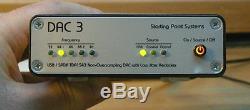USB / SPDIF Non-Oversampling NOS DAC TDA1543 DIR9001 2x9V NiMH (powers from USB)


A very innovative USB DAC blending modern tech with renowned TDA1543 true multibit Philips. ® chip for that pure. And with its very innovative on-board, always active, jitter-killing reclocker, it will sound equally good from all your sources: USB or SPDIF (coaxial and optical). Problematic, highly jittery sources, like set-top boxes, or wireless audio transmitters (airplay and the like) will now sound just like any well-designed high end transport.
It fits in the palm of your hand, and can be battery operated, so you can take it with you and have your friends enjoy it too! TDA1543 + Reclocker x (USB or DIR9001) + Battery power = GREAT SOUND! Why did you design this DAC?
Nobody can be "told" what a good DAC is, you have to hear it for yourself.. After searching myself for the "perfect" DAC, I stumbled on forum discussions about how these "vintage" DACs from Phillips® sounded so good. I was getting a little skeptical about those "natural" and "analog" statements for the sound of those converters, but as so many people seemed to make converging descriptions, I was left with the feeling it was not just a legend.. I decided I had to build one, and try for myself!
As the result was more than surprising... I told myself : wow, I got to show that to my friends... And what most of my friends said : can you build one for me?Call that a market study... Why do audiophiles do not like the sound of current oversampling DACs? Oversampling DACs are textbook correct, right?
So they should sound perfect, no? While it is true that oversampling DACs are textbook correct, if you make the wrong assumptions about the human hearing system, you may end up making mistakes, even if you do the math right! Let me give you a simple example : it is generally assumed we hear the spectrum of sounds, but can't hear the phase. Now try "binaural beats" on Google and listen for yourself. These clearly show the phase information IS sensed, AND remains present far inside the brain. So maybe the spectrum-only approach to DAC design is not telling the whole story... Traditional non-oversampling DACs from the past did not make any assumptions about hearing mechanisms, they just tried to replicate in analog what you fed them digitally as closely as possible.. What are the main features of this DAC? And what are the main goals of its design?Extract the pure performance of the last built non-oversampling true 16-bit TDA1543 DAC from Philips®. Provide equally high sound quality on either USB or SPDIF sources thanks to a very innovative reclocker. USB, Optical & Coaxial inputs (a simple press on the button switches them in round-robin fashion). NO DRIVER Install necessary: uses the stock drivers of your OS: Linux, MacOS, and yes, Windows too all flavors, XP, Win7/8...
Just plug on USB and it's your default sound output! Frequency indicator (works the same on all inputs) always tells you the REAL sample rate of your source (your computer/transport can't lie to you). DIR9001 96 kHz SPDIF Receiver.Supports sampling frequencies from 28kHz to 108kHz (continuous range, including non-standard frequencies). TDA1543 16-bit DAC - the original from Philips®. No Op-Amp - direct output with 2Vpp (will drive any power amp well). Huuuge capacitors on the output path provides sub-Hertz cutoff frequency.
Three Stage power supply regulation (for a super low background noise level). Separate voltage regulator for the DAC and the Digital SPDIF receiver (same reason as above). Battery-powered with dual 9V NiMH batteries.
Smart battery charger on-board (quickly charges the batteries when depleted, keeps them charged at low current when idle). Will Directly drive any power amplifier or preamp.
Easy to carry around and make it listen to yours friends. 2+ hours of listening on the batteries, if used standalone with spdif source. How can such a small device sound so good? The less you process sound, by adding unnecessary stages, the more transparent result you get.
A minimalist non-oversampling DAC will achieve that goal, and by being transparent, will give you great musical pleasure, and deep connection to musical emotions... What are owners of your DACs saying? The DAC3 digs deep into recordings and uncovers subtle musical details that I've missed using other DAC's. It also sounds very analogue and not at all harsh.
These are evaluations of my DAC 3... 1x DAC 3 2x NiMH Batteries inside. Note : power supply is not included, as it's designed to power from USB external power adapters are supported too, any 12V-24V (15V 1A recommended) wall transformer will do, laptop supplies are ok too, car power also.. Video with detailed explanations on the design of this DAC. USB Audio DAC with jitter killer reclocker crowdfunding pitch - YouTube. Video will open in a new window. If like me, you have the habit of cranking up the volume knob of your amp just to check if the device connected to it has its power on... Don't do it with that DAC! It's background noise is so low (no kidding) it just will fool you into thinking it's maybe not connected. Pressing the "play" key on your CD transport or favorite PC software will blow your speakers, kill your ears, piss-off your neighbors... Well, it happened to me..The item "USB / SPDIF Non-Oversampling NOS DAC TDA1543 DIR9001 2x9V NiMH (powers from USB)" is in sale since Thursday, December 17, 2015. This item is in the category "Consumer Electronics\TV, Video & Home Audio\TV, Video & Audio Parts\Amplifier Parts & Components". The seller is "leopardo42" and is located in Paris.
This item can be shipped worldwide.
- Country/Region of Manufacture: France
- Type: R2R (true multibit) DAC with reclocker
- MPN: DAC 3
- Brand: Starting Point Systems

